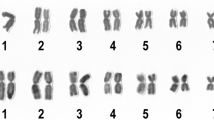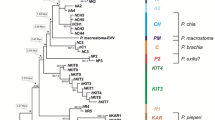Abstract
Among recent lemmings (D. torquatus from the Yamal Peninsula and D. groenlandicus from Somerset, Bathurst, Melville, and Devon islands), there are populations with archaic sets of morphotypes characteristic of the end of the Late Pleistocene. In some parts of the species range, lemming morphotypes follow the pattern characteristic of the Holocene stage of their evolution. Lemmings with the best developed tooth system live in the Bering Sea sector of the Arctic (Wrangel Island, Chukotka and Alaska). The correspondence of the boundaries of the groups distinguished by odontological traits to the phylogeographic data on mitochondrial DNA (mtDNA) and chromosomal groups is discussed.
Similar content being viewed by others
References
Fedorov, V.B. and Goropashnaya, A.V., The Importance of Ice Ages in Diversifications of Arctic Collared Lemmings (Dicrostonyx): Evidence from the Mitochondrial Cytochrome b Region, Hereditas (Lund, Swed.), 1999, vol. 130, pp. 301–307.
Fedorov, V.B. and Stenseth, N.C., Multiple Glacial Refugia in the North American Arctic: Inference from Phylogeography of the Collared Lemming (Dicrostonyx groenlandicus), Proc. R. Soc. London, B, 2002, vol. 269, pp. 2071–2077.
Fedorov, V., Fredga, K., and Jarrell, G.H., Mitochondrial DNA Variation and the Evolutionary History of Chromosome Races of Collared Lemmings (Dicrostonyx) In the Eurasian Arctic, J. Evol. Biol., 1999, vol. 12, pp. 134–145.
Fredga, K. and Fedorov, V.B., Chromosomal Evolution in Nearctic Collared Lemmings, Polarforskningssekretariatet. Arsbok 1999, Stockholm, 1999, pp. 104–106.
Gileva, E.A., Chromosomal Diversity and an Aberrant Genetic System of Sex Determination in the Arctic Lemming, Dicrostonyx torquatus Pallas (1779), Genetica (The Hague), 1980, vol. 52/53, pp. 99–103.
Gileva, E.A., Khopunova, S.E., Novokshanova, T.G., and Zybina, E.V., Chromosomal Speciation and Folliculogenesis in the Semisterile Interspecific Hybrids of the Varying Lemmings, Genus Dicrostonyx, Zh. Obshch. Biol., 1994, vol. 55, no. 6, pp. 700–707.
Hall, E.R., The Mammals of North America, New York: Wiley, 1981.
Hantemirov, R.M. and Shiyatov, S.G., A Continuous Multimillennial Ring-Width Chronology in Yamal, Northwestern Siberia, Holocene, 2002, vol. 12, no. 6, pp. 717–726.
Late Pleistocene Distribution and Diversity of Mammals in Northern Eurasia (PALEOPHAUNA Database), Paleontol. Evol., 1995, vols. 28–29, pp. 5–143.
Macpherson, A.H., The Origin of Diversity in Mammals of the Canadian Arctic Tundra, Syst. Zool., 1965, vol. 14, pp. 153–173.
Nei, M. and Kumar, S., Molecular Evolution and Phylogenetics, Oxford Univ. Press, 2002.
Smirnov, N.G., Zonal Distribution of Mammals in the Upper Valdai in the Urals, Mamont i ego okruzhenie: 200 let izucheniya (The Mammoth and Its Environment: 200 Years of Study), Moscow: GEOS, 2001, pp. 209–219.
Smirnov, N.G., The Rate of Morphological Changes in Populations as a Characteristic of the Chronological Structure of the Evolutionary Process, in Populyatsii, soobshchestva, evolyutsiya (Populations, Communities, Evolution), Kazan: Novoe Znanie, 2002, part 2, pp. 190–210.
Smirnov, N.G. and Golovachov, I.B., Holocene History of Small Mammals in the Urals, Archaeol. Euras., 1999, vol. 6, pp. 209–221.
Smirnov, N.G., Bol'shakov, V.N., and Borodin, A.V., Pleistotsenovye gryzuny Severa Zapadnoi Sibiri (Pleistocene Rodents in the Northern Part of Western Siberia), Moscow: Nauka, 1986.
Smirnov, N.G., Golovachev, I.B., Bachura, O.P., Kuznetsova, I.A., and Cheprakov, M.I., Difficult Cases of Tooth Determination in Rodents from the Upper Pleistocene and Holocene Deposits in the Tundra Regions of Northern Eurasia, in Materialy po istorii i sovremennomu sostoyaniyu fauny severa Zapadnoi Sibiri (Materials on the History and Recent State of Fauna in the Northern Part of Western Siberia), Chelyabinsk: Rifei, 1997, pp. 60–90.
Sokal, R.R. and Rohlf, F.J., Biometry, New York: Freeman, 1995.
Zhivotovsky, L.A., The Indices of Population Similarity in Polymorphic Characters, Zh. Obshch. Biol., 1979, vol. 40, no. 4, pp. 587–601.
Author information
Authors and Affiliations
Rights and permissions
About this article
Cite this article
Smirnov, N.G., Fedorov, V.B. Holarctic Collared Lemmings: Traces of Their Spread as Related to the History of the Arctic Biota. Russian Journal of Ecology 34, 332–338 (2003). https://doi.org/10.1023/A:1025674226162
Issue Date:
DOI: https://doi.org/10.1023/A:1025674226162




